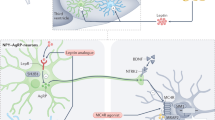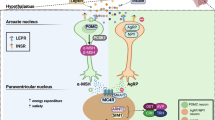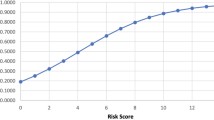Abstract
Study of monogenic forms of obesity has demonstrated the pivotal role of the central leptin–melanocortin pathway in controlling energy balance, appetite and body weight1. The majority of loss-of-function mutations (mostly recessive or co-dominant) have been identified in genes that are directly involved in leptin–melanocortin signaling. These genes, however, only explain obesity in <5% of cases, predominantly from outbred populations2. We previously showed that, in a consanguineous population in Pakistan, recessive mutations in known obesity-related genes explain ~30% of cases with severe obesity3,4,5. These data suggested that new monogenic forms of obesity could also be identified in this population. Here we identify and functionally characterize homozygous mutations in the ADCY3 gene encoding adenylate cyclase 3 in children with severe obesity from consanguineous Pakistani families, as well as compound heterozygous mutations in a severely obese child of European-American descent. These findings highlight ADCY3 as an important mediator of energy homeostasis and an attractive pharmacological target in the treatment of obesity.
This is a preview of subscription content, access via your institution
Access options
Access Nature and 54 other Nature Portfolio journals
Get Nature+, our best-value online-access subscription
27,99 € / 30 days
cancel any time
Subscribe to this journal
Receive 12 print issues and online access
209,00 € per year
only 17,42 € per issue
Buy this article
- Purchase on SpringerLink
- Instant access to full article PDF
Prices may be subject to local taxes which are calculated during checkout


Similar content being viewed by others
References
El-Sayed Moustafa, J. S. & Froguel, P. From obesity genetics to the future of personalized obesity therapy. Nat. Rev. Endocrinol. 9, 402–413 (2013).
Froguel, P. & Blakemore, A. I. The power of the extreme in elucidating obesity. N. Engl. J. Med. 359, 891–893 (2008).
Saeed, S. et al. Novel LEPR mutations in obese Pakistani children identified by PCR-based enrichment and next-generation sequencing. Obesity (Silver Spring) 22, 1112–1117 (2014).
Saeed, S. et al. Genetic variants in LEP, LEPR and MC4R explain 30% of severeobesity in children from a consanguineous population. Obesity (Silver Spring) 23, 1687–1695 (2015).
Saeed, S., Butt, T. A., Anwer, M., Arslan, M. & Froguel, P. High prevalence of leptin and melanocortin-4 receptor gene mutations in children with severe obesity from Pakistani consanguineous families. Mol. Genet. Metab. 106, 121–126 (2012).
Kopelman, P. G. Obesity as a medical problem. Nature 404, 635–643 (2000).
World Health Organization. A Snapshot of Global Health (World Health Organization, Geneva, 2012).
Stunkard, A. J., Harris, J. R., Pedersen, N. L. & McClearn, G. E. The body mass index of twins who have been reared apart. N. Engl. J. Med. 322, 1483–1487 (1990).
Wang, Z. et al. Adult type 3 adenylyl-cyclase-deficient mice are obese. PLoS One 4, e6979 (2009).
Wong, S. T. et al. Disruption of the type III adenylyl cyclase gene leads to peripheral and behavioral anosmia in transgenic mice. Neuron 27, 487–497 (2000).
Cao, H., Chen, X., Yang, Y. & Storm, D. R. Disruption of type 3 adenylyl cyclase expression in the hypothalamus leads to obesity. Integr Obes Diabetes 2, 225–228 (2016).
Pitman, J. L. et al. A gain-of-function mutation in adenylate cyclase 3 protects mice from diet-induced obesity. PLoS One 9, e110226 (2014).
Hanoune, J. & Defer, N. Regulation and role of adenylyl cyclase isoforms. Annu. Rev. Pharmacol. Toxicol. 41, 145–174 (2001).
Kanoski, S. E., Fortin, S. M., Arnold, M., Grill, H. J. & Hayes, M. R. Peripheral and central GLP1 receptor populations mediate the anorectic effects of peripherally administered GLP1 receptor agonists, liraglutide and exendin-4. Endocrinology 152, 3103–3112 (2011).
Liang, Y. et al. Hepatic adenylate cyclase 3 is upregulated by liraglutide and subsequently plays a protective role in insulin resistance and obesity. Nutr. Diabetes 6, e191 (2016).
Ando, T. et al. Liraglutide as a potentially useful agent for regulating appetite in diabetic patients with hypothalamic hyperphagia and obesity. Intern. Med. 53, 1791–1795 (2014).
Madsen, L. & Kristiansen, K. The importance of dietary modulation of cAMP and insulin signaling in adipose tissue and the development of obesity. Ann. NY Acad. Sci. 1190, 1–14 (2010).
Tong, T., Shen, Y., Lee, H. W., Yu, R. & Park, T. Adenylyl cyclase 3 haplo-insufficiency confers susceptibility to diet-induced obesity and insulin resistance in mice. Sci. Rep. 6, 34179 (2016).
Warrington, N. M. et al. A genome-wide association study of body mass index across early life and childhood. Int. J. Epidemiol. 44, 700–712 (2015).
Speliotes, E. K. et al. Association analyses of 249,796 individuals reveal 18 new loci associated with body mass index. Nat. Genet. 42, 937–948 (2010).
Wen, W. et al. Meta-analysis identifies common variants associated with body mass index in east Asians. Nat. Genet. 44, 307–311 (2012).
Monda, K. L. et al. A meta-analysis identifies new loci associated with body mass index in individuals of African ancestry. Nat. Genet. 45, 690–696 (2013).
Stergiakouli, E. et al. Genome-wide association study of height-adjusted BMI in childhood identifies functional variant in ADCY3. Obesity (Silver Spring) 22, 2252–2259 (2014).
Felix, J. F. et al. Genome-wide association analysis identifies three new susceptibility loci for childhood body mass index. Hum. Mol. Genet. 25, 389–403 (2016).
Liu, J. Z. et al. Association analyses identify 38 susceptibility loci for inflammatory bowel disease and highlight shared genetic risk across populations. Nat. Genet. 47, 979–986 (2015).
Voisin, S. et al. Many obesity-associated SNPs strongly associate with DNA methylation changes at proximal promoters and enhancers. Genome Med. 7, 103 (2015).
Liu, X. et al. Maternal preconception body mass index and offspring cord blood DNA methylation: exploration of early life origins of disease. Environ. Mol. Mutagen. 55, 223–230 (2014).
Trott, O. & Olson, A. J. AutoDock Vina: improving the speed and accuracy of docking with a new scoring function, efficient optimization and multithreading. J. Comput. Chem. 31, 455–461 (2010).
Boal, F., Laguerre, M., Milochau, A., Lang, J. & Scotti, P. A. A charged prominence in the linker ___domain of the cysteine-string protein Cspα mediates its regulated interaction with the calcium sensor synaptotagmin 9 during exocytosis. FASEB J. 25, 132–143 (2011).
Roger, B. et al. Adenylyl cyclase 8 is central to glucagon-like peptide 1 signaling and effects of chronically elevated glucose in rat and human pancreatic beta cells. Diabetologia 54, 390–402 (2011).
Ferdaoussi, M. et al. Exendin-4 protects beta cells from interleukin-1β-induced apoptosis by interfering with the c-Jun NH2-terminal kinase pathway. Diabetes 57, 1205–1215 (2008).
Acknowledgements
The authors thank the patients and their families for participation in the study. We are grateful to A. W. Rathore for clinical facilitation, Z. Gilani for his advice regarding ADCY3 molecular modeling, M. Boissel for help with statistical analyses, and Q. Ain and I. Qureshi for their technical assistance. This study was supported by the Fédération de Recherche 3508 Labex EGID (European Genomics Institute for Diabetes; ANR-10-LABX-46) (to P.F.), the ANR Equipex 2010 session (ANR-10-EQPX-07-01; ‘LIGAN-PM’) (to P.F.), the European Community (FEDER) and the Region Hauts-de-France (to P.F.). The research leading to this study was also supported by funding from the European Research Council GEPIDIAB 294785 (P.F.) and the Pakistan Academy of Sciences (to M. Arslan).
Author information
Authors and Affiliations
Contributions
S.S., A.B., M. Arslan and P.F. designed the study and wrote the first draft of the paper. S.S., Q.M.J., S.M.D., A.H. and M. Arslan collected samples and performed biochemical analyses. A.B., E.D., O.S., T.R., E.V., I.R., S.S. and F.D.G. performed whole-exome sequencing and analyzed the genetic data. J.M., H.A., D.A.S., M. Ali, W.I.K., T.A.B. and C.S. identified and recruited families with obese individuals. F.T., J.G., A.M., G.Q., R.B., A.A. and J.L. performed the functional experiments and analyzed the data. M.U.M. performed the structural analysis. All authors contributed to the final version of the manuscript.
Corresponding author
Ethics declarations
Competing interests
The authors declare no competing financial interests.
Additional information
Publisher’s note: Springer Nature remains neutral with regard to jurisdictional claims in published maps and institutional affiliations.
Integrated supplementary information
Supplementary Figure 1 Sequencing scans of ADCY3 in the four probands (P1–P4) at the site of mutation.
mutADCY3-I is a 1-base deletion that lies in the last exon (coding exon 21) of the ADCY3 gene resulting in a truncated protein by introducing a stop codon after two aberrant amino acids; mutADCY3-II is a substitution at a splice acceptor site in intron 15 that abolishes this site as predicted by the Human Splicing Finder (Supplementary Note) resulting in skipping of exon 16. As a consequence, the protein carries 1,091 amino acids rather than the normal number of 1,144 amino acids; mutADCY3-III is a missense mutation (Asn>Ile) that lies in exon 1 of ADCY3; mutADCY3-IV is a compound heterozygous mutation, mutADCY3-IVa is a frameshift mutation and mutADCY3-IVb is an in-frame 3-base deletion. mutADCY3-IVa results in a change from Gly to Ala at amino acid 423 leading to 18 aberrant amino acids before introducing a stop codon. mutADCY3-IVb results in deletion of the Phe at amino acid position 1118.
Supplementary Figure 2 Conservation of the ADCY3 mutated residues.
Comparative sequence analysis showing conservation of the mutated ADCY3 regions at the protein level. Top, protein alignment for the homozygous mutations from consanguineous families. Bottom, protein alignment for the compound heterozygous mutation. Nucleotides in intronic regions are shaded gray.
Supplementary Figure 3 ADCY3 expression in BHK cells subsequent to transient transfection with pcDNA3 alone (CON) or human ADCY3 constructs (wt, mut I–IVb).
a, Representative blots with anti-ADCY3 antibody (top) and anti-HSP70 antibody (bottom) as loading control. Molecular weight standards (in kDa) are given to the right. b, Quantification of blots normalized for each experiment to values obtained for ADCY3 wt. n = 7–9. Means are represented as horizontal bars, s.d. as boxes, s.e.m. as whiskers and points represent individual data. c, Coomassie Blue staining of the PVDF membrane shown in a.
Supplementary Figure 4 Immunofluorescence images of BHK cells transiently transfected with plasmids encoding Myc-tagged ADCY3 wild-type or mutants (I, II, III, IVb).
ADCY3 expression was visualized by either anti-Myc or anti-ADCY3 antibody followed by Cy3-coupled secondary antibody. Nuclei were stained with Hoechst 33342.
Supplementary Figure 5 Effect of ADCY3 wt and mutants on CreLuc activity.
CHO cells were transfected for 44 h with CreLuc reporter and either empty vector (Ctrl) or plasmids encoding Myc-tagged hADCY3wt (Wt) or hADCY3 mutants (Mut-I, Mut-II, Mut-III and Mut-IVb). Thereafter, culture medium was replaced and cells were cultured with a stimulatory medium containing 2% FCS and 1 μM forskolin plus 100 μM IBMX for 4 h. Luciferase activity was measured and normalized to β-galactosidase activity. The data are represented as the fold increase in luciferase activity in the stimulated condition over unstimulated cells in five independent experiments performed in triplicate and are expressed as the mean ± s.e.m. of three independent experiments performed in triplicate; an asterisk indicates significant differences: Mut-I vs. WT P = 0.017, Mut-II vs. WT P = 0.0025, Mut-III vs. WT P = 0.12, Mut-IV vs. WT P = 0.0041 (ANOVA and Bonferroni post hoc test).
Supplementary Figure 6 Characterization of SNP rs11676272 (p.Ser107Pro; mutant V).
a, cAMP generation in BHK cells stimulated by forskolin (1 μM, in the presence of 100 μM IBMX). An asterisk indicates significant differences: CON (n = 18) vs. WT (n = 18) P < 0.001, CON (n = 18) vs. mutant V (n = 8) P < 0.001; no significant difference between WT and mutant V (P = 0.054). Means are represented as horizontal bars, s.d. as boxes, s.e.m. as whiskers and points represent individual data. b, Western blot analysis for ADCY3 and tubulin (TUB) from transiently transfected BHK cells with Myc-tagged hADCY3wt (WT) or plasmid encoding ADCY3 carrying the variant rs11676272 (V). Molecular weight standards are given in kDa. Expression levels of mutant V were 70 + 41.4% of WT levels (n = 7–12). c, CHO cells were transfected for 44 h with CreLuc reporter and either empty vector (CON) or plasmid encoding either Myc-tagged hADCY3wt (WT) or ADCY3 carrying the variant rs11676272 (V). Thereafter, culture medium was replaced and cells were cultured with either a medium containing 2% FCS (unstimulated) or a medium containing 2% FCS and 1 μM forskolin plus 100 μM IBMX (stimulated) for 4 h. Luciferase activity was measured and normalized to β-galactosidase activity. The data are expressed as the mean ± s.e.m. of four independent experiments performed in triplicate. An asterisk indicates significant differences: WT vs. CON P = 0.032, CON vs. V P = 0.003, WT vs. V P = 0.66.
Supplementary Figure 7 Relative gene expression from cDNA of homozygous and heterozygous carriers of mutADCY3-1.
RNA was extracted from whole blood, and results were analyzed with the ΔΔCd method. Values are mean ± s.e.m. (n = 3 replicate measurements). No significant change was found in expression of the mutants relative to the wild-type.
Supplementary Figure 8 Graphical description of the wtADCY3-C1 ___domain.
a, Model-template sequence alignment. b, z score QMEAN, representing the model inside the non-redundant set of PDB structures regarding perfection. c, 3D structure of the C1 catalytic ___domain of wtADCY3. d, Superimposition of the C1 ___domain of Canis lupus (dog) ADCY5 (in pink) on the C1 ___domain of human wtADCY3 (in blue). More notably, the Mg-ATP key interacting residues in both structures are also conserved.
Supplementary Figure 9 Graphical description of the wtADCY3 C2 ___domain.
a, Model-template sequence alignment. b, z score QMEAN, representing the model inside the non-redundant set of PDB structures regarding perfection. c, 3D structure of the C2 catalytic ___domain of wtADCY3. d, Superimposition of the C2 ___domain of Rattus norvegicus (rat) ADCY2 (in pink) on the C2 ___domain of human wtADCY3 (in blue). Here the Mg-ATP key interacting residues in both structures are also conserved.
Supplementary information
Supplementary Text and Figures
Supplementary Figures 1–9, Supplementary Tables 1–10 and Supplementary Note
Rights and permissions
About this article
Cite this article
Saeed, S., Bonnefond, A., Tamanini, F. et al. Loss-of-function mutations in ADCY3 cause monogenic severe obesity. Nat Genet 50, 175–179 (2018). https://doi.org/10.1038/s41588-017-0023-6
Received:
Accepted:
Published:
Issue Date:
DOI: https://doi.org/10.1038/s41588-017-0023-6
This article is cited by
-
Obesity: pathophysiology and therapeutic interventions
Molecular Biomedicine (2025)
-
Obesity: exploring its connection to brain function through genetic and genomic perspectives
Molecular Psychiatry (2025)
-
Integrating Genetic Insights, Technological Advancements, Screening, and Personalized Pharmacological Interventions in Childhood Obesity
Advances in Therapy (2025)
-
The Interplay of UCP3 and PCSK1 Variants in Severe Obesity
Current Obesity Reports (2025)
-
The association between dietary, physical activity and the DNA methylation of PPARGC1A, HLA-DQA1 and ADCY3 in pregnant women with gestational diabetes mellitus: a nest case-control study
BMC Pregnancy and Childbirth (2024)



